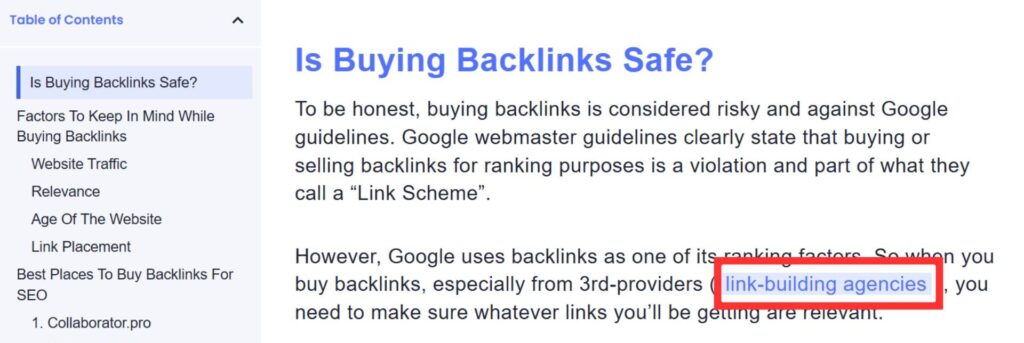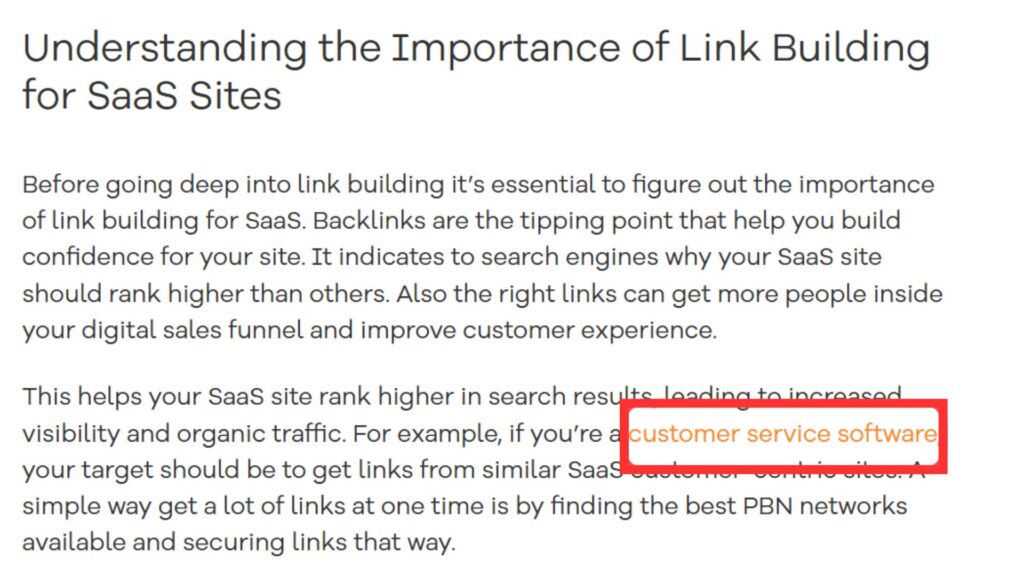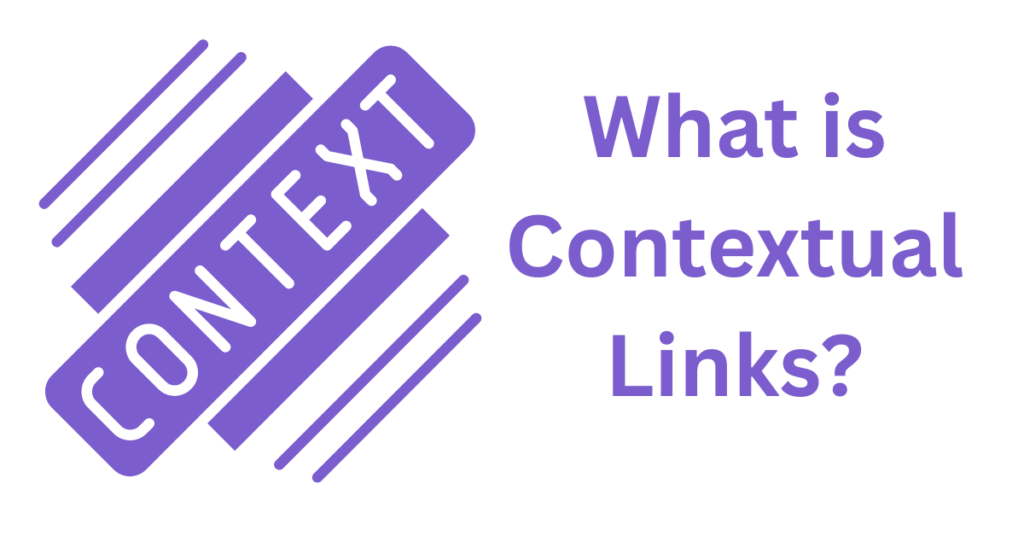Contextual backlinks are the kind of backlinks Google loves the most.
You’ve probably heard SEO experts talk about the importance of Quality Backlinks. Most of the time, they’re referring to contextual backlinks because these backlinks are placed naturally within the content.
These backlinks help build your topical authority, improve CTR (click-through rate), and provide real value to the readers.
What really matters to Google is who is linking to you and why.
If a reputable website in your niche refers to your website or specific content, that’s a strong signal that your site is credible and useful. In fact, a few solid contextual links from high-authority websites can easily outperform hundreds of random links from unrelated websites.
What are Contextual Backlinks?
Contextual backlinks are hyperlinks naturally placed within the main content of a webpage—this could be a blog post, an article, or any other content piece. These links either lead to the same website or to external sources.
The most important thing about contextual backlinks is relevance. The linked page should be directly related to the content it appears in.
In simple terms, these links are placed within the surrounding text in a way that makes sense, either to provide additional information about the content or to support the topic being discussed.
Let’s take an example of digitalmarketinginstitute.com blog, they have an article on “Email Marketing Complete Guide” and from that, they linked to another article on the anchor “buyer personas” as shown in the image below.
Types of Contextual Backlinks in SEO
1. Internal Contextual Links
2. External Contextual Links
3. Inbound Contextual Links
1. Internal Contextual Backlinks
These are links within your own website content that connect to other pages on your website. These links help users navigate more of your content. Plus, they help search engines understand your site’s structure.
Example:

In the above article on our website aryanjalan.com. We’ve a topic “best places to buy backlinks”, we have added an internal contextual link to our other article on “link-building agencies”.
Since this section discusses third-party providers, it makes sense to link to relevant content where users can explore trusted agencies if they’re looking for.
2. External Contextual Backlinks
External Contextual backlinks are links within your content that point to other websites. They are useful because the linked websites often provide additional information related to the topic you’re discussing. This helps enhance the reader’s understanding and adds credibility to your content.
Example:

The above article is about “How to build links to you SaaS site?” and they have added an external contextual link in the above section, with an anchor text to “customer service software”. This means they have naturally linked it to another helpful article titled “Best customer service software”
Since the linked article directly supports and adds more value to the topic being discussed, it’s a great example of an external contextual link.
3. Inbound Contextual Backlinks
Inbound Contextual backlinks are links from another website to your site. If a relevant website links to your page naturally within its content, that’s an inbound contextual backlink. These links are good for SEO and building site authority.
Example:

In Referral Candy’s article on “4 Super Easy Ways To Build Backlinks To Your Shopify Store,” they talk about what backlinks are. To make it more helpful, they used the anchor text “types of links” and linked it to our article on quality backlinks on our website, aryanjalan.com.
Since the link fits naturally within their content and connects to our site, it’s an inbound contextual link for us. It signals to search engines that our website’s content is trustworthy and authoritative within that topic area and help us bring more traffic to our site.
Benefits of Contextual Backlinks
High Referral Traffic
Contextual links appear inside useful content. They match what the user reads. So, clicks happen more naturally. This brings targeted traffic to your site. Visitors stay longer and convert better.
Here’s how different link types help:
- Internal links: Connect readers to key pages
- Inbound links: Bring traffic from similar websites
- External links: Offer helpful next steps or tools
Higher Domain Authority
Trusted websites pass on their authority. These links act as SEO boosters. Google sees them as signals of trust. With more of these, authority grows. Your site becomes stronger in Google’s eyes.
Each link type adds to your authority:
- Internal links: Strengthen internal page authority
- Inbound links: Gain trust from high-authority sites
- External links: Show research-backed references
Better Rankings
Contextual links use keyword-rich anchors. They help Google understand your page. Relevance and niche-matching matter a lot. These links support better keyword rankings. Pages rank higher over time.
How contextual links impact rankings:
- Internal links: Highlight keywords across pages
- Inbound links: Improve keyword-based rankings
- External links: Add context to your topic
More User Engagement
Smart links guide users to explore. They help visitors find related topics. This keeps them longer on your site. Bounce rate drops. Engagement and time-on-site go up.
Why each type boosts engagement:
- Internal links: Improve flow and session time
- Inbound links: Attract already-interested users
- External links: Make content more useful
Improves Credibility
Linking to trusted sources builds trust. It shows research and subject knowledge. Readers see value and accuracy. Google notices credible outbound linking too. Your content looks more reliable.
Here’s how credibility builds with links:
- Internal links: Reinforce topic depth and trust
- Inbound links: Earn recognition from others
- External links: Validate claims with strong sources
Popular Methods to Get Contextual Backlinks
1. Create High-quality content
Every backlink strategy starts here. No outreach tactic works well if the content isn’t good enough to earn a link. Most websites won’t link to something basic or outdated. They only link to content that adds value to their audience.
So what works?
Think of detailed guides, how-to articles, comparison posts, templates, or tools. Content that solves a specific problem or goes deeper than others in your niche. Keep it updated, well-structured, and optimized for both users and search engines.
Example: A well-written article titled “How to do a 3-Way Link Exchange in 2025” with real examples and outreach scripts is far more link-worthy than a basic post on “What is a Backlink?”
👉 This approach earns inbound links naturally. It also improves internal linking opportunities when you interconnect related pages. Plus, when you cite sources and add useful external links, it adds more credibility to your content.
2. Contribute to a Guest Post
Guest posting still works when done right. It’s about creating valuable content for someone else’s site — usually in your niche — and earning a contextual link back to your site within the content.
Here’s what makes it effective:
You can choose what page to link, control the anchor text, and make sure the link fits naturally. It also puts your brand in front of a new audience, which helps with authority and visibility.
Before pitching, study your competitors’ backlinks. Use tools like Ahrefs or Semrush to see which blogs they’ve written for. List the sites that are active, relevant, and have decent traffic.
Pitch useful, relevant ideas (not salesy ones) and always aim to add real value.
👉 This is a great way to build inbound links from authority sites. It also helps reinforce your external link profile if you cite good sources and improves internal SEO if you plan a content cluster around guest posts.
3. Implement Broken-link building
This method feels old-school but still works well. The idea is simple:
Find broken links on websites in your niche, then reach out and suggest your content as a replacement.
Broken links damage user experience — and site owners are usually happy to fix them if you help. You can spot them using Chrome extensions or by checking your competitors’ backlink profile. Once you identify broken URLs, either match them with your existing content or create something fresh to replace them.
Keep your outreach helpful and simple. You’re doing them a favor, not asking for one.
👉 This helps you earn contextual inbound links while showing you’re proactive. If you build a fresh piece to replace the broken one, it’s also a great way to create new internal linking touchpoints.
4. Manual link-building Outreach
Manual outreach is about directly connecting with blog editors or content managers. Instead of pitching a full guest post, you offer to contribute a short section to an already published article — usually with a backlink included.
This strategy is efficient when done at scale. You save time, skip content writing from scratch, and still get a relevant, in-content backlink.
But it only works when the link fits naturally. Always check that your suggested content adds something useful to the article. A “salesy” or forced link gets ignored or removed.
👉 This method builds inbound links quickly. It also helps with external linking if your added snippet refers to stats, examples, or sources. And you can internally link your inserted content back to other relevant pages on your site.
5. Pitch to Resource Pages
Resource pages are curated lists of useful articles, tools, or guides. They exist on educational, SaaS, nonprofit, and marketing blogs. These are great for getting clean, contextual backlinks — without creating new content.
Start by searching for terms like “{your topic} + resources” or “helpful tools for {your niche}”. Find pages that are still active and accept new suggestions.
Pitch your content with a short reason why it adds value. For example, a Free SEO Template for Outreach Tracking would fit well on a Resources for Link Building page.
👉 This method earns inbound links from trusted sources. It also pushes you to keep your page optimized and internally structured. Add a few external references within the page to make it even more valuable.
6. Use HARO or Qwoted for Press Mentions
HARO (Help a Reporter Out) and Qwoted connect journalists with expert quotes. You sign up, monitor daily requests, and respond to the ones in your niche.
If selected, your quote gets published — often with your name, company, and a backlink. These links usually come from strong websites: news outlets, SaaS blogs, or B2B platforms.
To succeed, respond fast. Keep your answers short, insightful, and jargon-free. Over time, this builds a natural, high-authority backlink profile — with zero cold emails.
👉 This is one of the most trusted ways to get inbound links. Even if you don’t control the anchor text, the link placement is natural. You can later link back to these mentions from your internal content, building a credibility loop.
Apart from the above methods…
You can also build hundreds of quality contextual backlinks just by partnering with content managers at companies in your niche. It doesn’t always have to be cold outreach or guest posts.
I’m talking about barter deals — like guest post swaps, 3-way link exchanges, or even link-for-link edits. These are faster, more scalable, and work especially well when both sides are trying to grow.
But here’s the real issue: Once you’re managing 10–15 of these deals at a time, it gets messy. Spreadsheets fall apart. Emails get lost. People forget. Links don’t go live.
That’s exactly why I built BacklinkCRM — a tool that helps SEO folks and agencies manage all their backlink partnerships in one place. We use it every day to:
- Handle 1:1, 2:3, and 3:2 link exchanges fairly
- Track which links are live, pending, or broken
- Keep a clean record of all collaborations
- Avoid link drops, delays, and messy follow-up
If you’re running multiple link-building campaigns or working with partners across different projects — this saves serious time.
👉 It’s not just for inbound links. You can also track internal opportunities and external links placed across projects. Everything stays organized.
Conclusion
Contextual backlinks are one of the best ways to improve your website’s SEO. When links are placed naturally inside relevant content, they help search engines understand your page and give users more helpful information.
Focus on creating useful content, building real connections, and using simple strategies like guest posts or broken link outreach. Over time, this leads to better rankings, more traffic, and stronger authority.
Explore More: Best Link Building Companies 2025
FAQs on Contextual Backlinks
1)- What’s the difference between contextual and non-contextual links?
Ans- Contextual Links = Inside the main content of the page
Non-contextual Links = In sidebars, footers, or menus.
2)- Why are contextual links better?
Ans- Contextual links are better because they’re placed right inside the content. And it feels more natural to readers, and Google trusts them more.
3)- What makes a contextual link strong?
Ans- A strong contextual link comes from a trusted website, is placed naturally within the content, and is relevant to the topic being discussed.
4)- What are the types of contextual links?
Ans- Internal, external, and inbound.
5)- How do you add a contextual link?
Ans- To add a contextual link, just pick a word or phrase in your content and link it to a page that adds value or gives more info about that topic.

